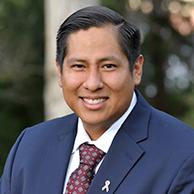 From the Advocate
From the Advocate
October 2022
Doubling Down on an Equitable California
Success, Capital Access and Leadership for Entrepreneurs
Have you ever had a day on the job where you say to yourself, “Oh that’s right, that’s why I’m here? This is why I gotta keep going.” If you have, you know that it’s a good feeling, a moment of sudden clarity and reassurance that you’re on the right path and it’s all worth it.
I was blessed to live one of these days recently.
On September 13, Governor Newsom issued an executive order directing state agencies — every state agency — to take additional actions to embed equity analysis and considerations in their mission, policies and practices and to take critical actions on equity and discrimination.
The goal of reducing the racial wealth gap through the support of successful entrepreneurship is already the mission that has driven most of my career and carried me to this position. However, reading such a sweeping directive from the Governor reminded me what a responsibility and an honor it is to lead an office equipped to help reduce racial inequality in an Administration that expects real results.
This month, I want to review three ways that the California Office of the Small Business Advocate is trying harder in our ongoing efforts to help create a California For All.
First, let me remind us of how that lack of equity manifests in our small business sector.
California already has the largest and most diverse small business sector in the United States. But while nearly 45 percent of the 4.2 million small businesses in California are owned by Hispanics or racial minorities, this doesn’t add up to equitable wealth outcomes.
According to the Prosperity Now Scorecard, California ranks 19 in racial disparity and 15 in overall outcomes compared to 49 other states and the District of Columbia. I’ll make my point with just three charts (all from the Prosperity Now Scorecard based on census data from the 2012 Survey of Business Owners).
Business Ownership by Race, California

Avg. Business Value by Race, Employer Businesses, California

Avg. Business Value by Race, Non-Employer Businesses, California

Consider also that only 12.7 percent of businesses owned by Hispanics or racial minorities have employees compared to 18.1 percent of businesses by whites, according to SBA state profile data.
I could go on and on nonetheless I think the point is made.
So, what are we doing about it? Let me cite three new efforts already underway in my office.
- Required Equity Action Plan for Technical Assistance Providers
CalOSBA defines “underserved business groups” to include businesses owned by: women, minorities (people of color), veteran-owned businesses, and businesses in low wealth, rural and disaster-impacted communities included in a state or federal emergency declaration or proclamation.
Nearly all of our programs are designed to serve these underserved business groups and we are continuously refining our policies and guidelines to this end. This year we upped the ante for the 102 small business centers supported by this year’s $23 million in Technical Assistance Program funding by adding that new requirement to the grant application: the submission of an Equity Action Plan.
The requirement is intended to help us better map the program outcomes in terms of populations served, language services rendered, and, overall, the development of a better understanding of where these underserved groups are located and what precisely we are doing to reach them.
We have just issued the Letters of Intent to the new designees but expect to hear further reporting from this office about these outcomes.
- New Capital Earmarked for Socially and Economically Disadvantaged Individuals (SEDI) and Very Small Businesses
The Governor also announced in September the arrival of $1.1 billion in new funding from the U.S. Treasury’s State Small Business Credit Initiative (SSBCI) to support California’s small businesses, particularly those in Socially and Economically Disadvantaged (SEDI) populations.
This funding will refresh the available funds of three credit support programs in California: the Small Business Loan Guarantee Program (administered by iBank) and the Collateral Support Program and the California Capital Access Program (CalCAP) for Small Business (both administered by the California Pollution Control Financing Authority, CPCFA).
This is not a surprise: the funding was authorized under the federal American Rescue Plan Act of 2021. The exciting part is that the money is now safely arrived in California. You can see a list of currently participating lenders right now: FY-21-22-Participating-Lenders.pdf (ca.gov)
My team and the 102 Technical Assistance Partners are looking forward to new ways of working with our colleagues at iBank andthe CPCFA to help get these funds successfully deployed to those SEDI populations, populations that we believe closely align with the underserved business groups we target through TAP.
- Team: Implicit Bias Training
Another element that I think about as Director is making sure that my team is always focused on questions of Diversity and Equity and has the awareness required to implement these principles through everything we do. It’s baked into the programs they administer but that’s not enough: I also want to make sure that each member of my team develops an Ally mindset.
To this end, several months ago, I mandated that every member of my team complete Implicit Bias Training, a requirement that has now been adopted for the entire GO-Biz office.
I want to recognize that these three actions alone don’t add up to a magic solution. While, there is so much more that we have to do in support of Executive Order N-16-22.
More importantly, this effort and this challenge, is the reason I get up every day and I’m grateful for the Governor’s Executive Order to reenergize and validate my efforts, my team’s efforts, and those of every state employee who also dreams of a California for All.


















































